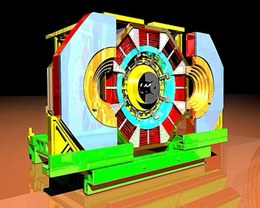BES III
Das BES III Experiment in Beijing untersucht Charmonium Produktion und Zerfälle in e+e- Kollisionen.
 |
The Beijing Spectrometer III (BES III) is the main detector at Beijing Electron-Positron Collider II (BEPC II) in Beijing, China. With a luminosity that is 100 times higher than it was in BEPC I, BES III is designed to do precise studies in light hadron spectroscopy, charmonium, to investigate elektroweak and strong physics at the charm scale and even search for new physics. The JLU Giessen is one of the first Universities in Germany being a member of the BES III group and the expertise along with new computing equipment we can provide some interesting fields in physics to work on. |
|---|
Physical Motivation
The Standard Model has been successful at describing all relevant experimental phenomena and has been generally accepted as the fundamental theory of elementary particle physics. Despite its success, the SM leaves many unanswered questions. These can be classified into two main categories: one for subjects related to possible new physics at unexplored energy scales and the other for nonperturbertive physics, mostly related to Quantum Chromodynamics.
The second category includes questions about nonperturbative effects. QCD, the fundamental theory of the strong interactions, is well tested at short distances, but at long distances nonperturbative effects become important and these are not well understood. The effects are very basic to the field of particle physics and include e.g. the structure of hadrons and the spectrum of hadronic states. Lower energy facilities with high luminosity can address these questions. Among these, the Beijing Electron Positron Collider II (BEPCII), which will operate in the 2 GeV to 4.6 GeV energy range, will be an important contributor. This is because it spans the energy range where both short-distance and long-distance effects can be probed.
The BEPCII energy range includes the threshold of charmonia. The discoveries of the low-lying charmonium states and of open-charmed hadrons were instrumental for the acceptance of quarks as truly dynamical entities in general, and of the SM in particular. The surprising discoveries of the narrow D_sJ mesons, several hidden charm resonances around 4 GeV region, and the X(1835) at BESII during the past few years have considerably enhanced the interest in the study of the spectroscopy of hadrons with and without open charm. The high energy physics community has realized that comprehensive studies of e+ e- annihilation in the charm-tau threshold region can teach us novel and unique lessons on hadronization and the interplay of perturbative and nonperturbative dynamics. This has great value both in its own right and for its contributions to improve the discovery potential for new physics in the decays of B mesons studied at LHCb and the B-factories. The significance of physics around the threshold of charmonia is also illustrated by the fact that the Super-B factories being designed at Frascati and KEK both include the capability of running in the 4 GeV region.
